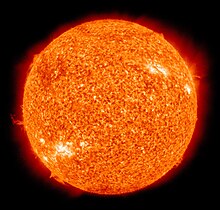ទំព័រគំរូ:Sun
 | |
| Observation data | |
|---|---|
| Mean distance from Earth |
១.496×10៨ គ.ម. 8 min 19 s at light speed |
| Visual brightness (V) | −26.74[១] |
| Absolute magnitude | 4.83[១] |
| Spectral classification | G2V |
| Metallicity | Z = 0.0122[២] |
| Angular size | 31.6′ – 32.7′[៣] |
| Adjectives | Solar |
| Orbital characteristics | |
| Mean distance from Milky Way core |
~២.5×10១៧ គ.ម. ២៦០០០ light-years |
| Galactic period | (2.25–2.50)×10៨ a |
| Velocity | ~២២០ km/s (orbit around the center of the Galaxy) ~២០ km/s (relative to average velocity of other stars in stellar neighborhood) ~៣៧០ km/s[៤] (relative to the cosmic microwave background) |
| Physical characteristics | |
| Mean diameter | ១.392684×10៦ គ.ម.[៥] |
| Equatorial radius | ៦.96342×10៥ គ.ម.[៥] 109 × Earth[៦] |
| Equatorial circumference | ៤.379×10៦ គ.ម.[៦] 109 × Earth[៦] |
| Flattening | ៩×10−៦ |
| Surface area | ៦.0877×10១២ km2 [៦] ១១៩៩០ × Earth[៦] |
| Volume | ១.412×10១៨ km3[៦] ១៣០០០០០ × Earth |
| Mass | ១.9891×10៣០ kg[១] ៣៣៣០០០ × Earth[១] |
| Average density | ១.408×10៣ kg/m3[១][៦][៧] |
| Density | Center (model): ១.622×10៥ kg/m3[១] Lower photosphere: ២×10−៤ kg/m3 Lower chromosphere: ៥×10−៦ kg/m3 Corona (avg): ១×10−១២ kg/m3[៨] |
| Equatorial surface gravity | ២៧៤.0 m/s2[១] ២៧.94 g ២៧៥៤២.29 cgs 28 × Earth[៦] |
| Escape velocity (from the surface) |
៦១៧.7 km/s[៦] 55 × Earth[៦] |
| Temperature | Center (modeled): ~១.57×10៧ K[១] Photosphere (effective): ៥៧៧៨ K[១] Corona: ~៥×10៦ K |
| Luminosity (Lsol) | ៣.846×10២៦ W[១] ~៣.75×10២៨ lm ~៩៨ lm/W efficacy |
| Mean intensity (Isol) | ២.009×10៧ W·m−2·sr−1 |
| Age | 4.57 billion years[៩] |
| Rotation characteristics | |
| Obliquity | 7.25°[១] (to the ecliptic) 67.23° (to the galactic plane) |
| Right ascension of North pole[១០] |
286.13° 19 h 4 min 30 s |
| Declination of North pole |
+63.87° 63° 52' North |
| Sidereal rotation period (at equator) |
25.05 days[១] |
| (at 16° latitude) | 25.38 days[១] 25 d 9 h 7 min 12 s[១០] |
| (at poles) | 34.4 days[១] |
| Rotation velocity (at equator) |
៧.189×10៣ km/h[៦] |
| Photospheric composition (by mass) | |
| Hydrogen | 73.46%[១១] |
| Helium | 24.85% |
| Oxygen | 0.77% |
| Carbon | 0.29% |
| Iron | 0.16% |
| Neon | 0.12% |
| Nitrogen | 0.09% |
| Silicon | 0.07% |
| Magnesium | 0.05% |
| Sulfur | 0.04% |
ឯកសារយោង
ឯកសារយោងទាំងនេះនឹងបង្ហាញក្នុងអត្ថបទនេះ ប៉ុន្តែបញ្ជីនេះបង្ហាញត្រឹមតែលើទំព័រនេះទេ។
- ↑ ១,០០ ១,០១ ១,០២ ១,០៣ ១,០៤ ១,០៥ ១,០៦ ១,០៧ ១,០៨ ១,០៩ ១,១០ ១,១១ ១,១២ ១,១៣ Williams, D. R. (2004). "Sun Fact Sheet". NASA. Retrieved 2010-09-27.
- ↑ Asplund, M., N. Grevesse and A. J. Sauval (2006). "The new solar abundances - Part I: the observations". Communications in Asteroseismology 147: 76–79. DOI:10.1553/cia147s76.
- ↑ "Eclipse 99: Frequently Asked Questions". NASA. Retrieved 2010-10-24.
- ↑ Hinshaw, G., et al. (2009). "Five-year Wilkinson Microwave Anisotropy Probe observations: data processing, sky maps, and basic results". The Astrophysical Journal Supplement Series 180 (2): 225–245. DOI:10.1088/0067-0049/180/2/225.
- ↑ ៥,០ ៥,១ Emilio, Marcelo; Kuhn, Jeff R.; Bush, Rock I.; Scholl, Isabelle F. (៥ ខែមីនា ២០១២), Measuring the Solar Radius from Space during the 2003 and 2006 Mercury Transits, http://arxiv.org/abs/1203.4898, បានយកមក March 28, 2012
- ↑ ៦,០០ ៦,០១ ៦,០២ ៦,០៣ ៦,០៤ ៦,០៥ ៦,០៦ ៦,០៧ ៦,០៨ ៦,០៩ ៦,១០ "Solar System Exploration: Planets: Sun: Facts & Figures". NASA. Archived from the original on 2008-01-02.
- ↑ Ko, M. (1999). Elert, G. (ed.). "Density of the Sun". The Physics Factbook.
- ↑ "Principles of Spectroscopy". University of Michigan, Astronomy Department. 30 August 2007.
- ↑ Bonanno, A. (2008). "The age of the Sun and the relativistic corrections in the EOS". Astronomy and Astrophysics 390 (3): 1115–1118. DOI:10.1051/0004-6361:20020749.
- ↑ ១០,០ ១០,១
Seidelmann, P. K. (2000). "Report Of The IAU/IAG Working Group On Cartographic Coordinates And Rotational Elements Of The Planets And Satellites: 2000". Retrieved 2006-03-22.
{{cite web}}: Unknown parameter|coauthors=ignored (|author=suggested) (help) - ↑ "The Sun's Vital Statistics". Stanford Solar Center. Retrieved 2008-07-29., citing Eddy, J. (1979). A New Sun: The Solar Results From Skylab. NASA. p. 37. NASA SP-402. http://history.nasa.gov/SP-402/contents.htm.